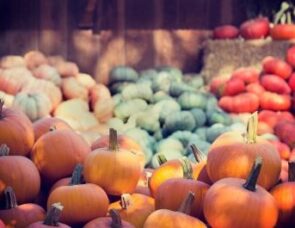This is an outline for a series of RE lessons for a Foundation class on the themes of harvest and the importance of saying thank you.

Introduction
Here is an outline for a series of RE lessons for a Foundation class on the themes of harvest and the importance of saying thank you. The intended learning outcomes are:
- to recognise the importance of saying thank you;
- to associate saying thank you with the festival of Harvest (Harvest being the time when Christians say thank you to God);
- to identify and make simple observations about some features of a Christian harvest festival.
Development
- When do people say thank you?
- Ask the children what kind words they know – focus on the words please and thank you. When do they say these words? Why?
- Model for the children a role-play of asking ‘please may I have’ and responding ‘thank you very much’.
- Make the classroom role-play corner into a kindness/politeness corner. So when they buy things or ask for objects stored in the corner, the children can only get out these objects if they ask using please and thank you rules.
- Why is it important to say thank you to people?
- Read a story like ‘The Elephant and the Bad Baby’, who never said please or thank you or a text with a similar theme. Ask children why is it important to say thank you to people? If you stopped saying thank you, what would happen?
- To which people in school and at home do we say thank you and what for? Make a thank you card for someone to say that they are appreciated for something they have done.
- Link to the next session by considering what things we can be thankful for and without which we can’t live. Focus on food in particular.
- How can we show that we are thankful for food?
- Ask children what food they eat? Look at what are the children’s favourite foods? Children should cut out pictures from magazines or draw their own pictures.
- Prepare a ‘thank you for food’ day. Decorate the classroom, make cards, taste special foods, prepare a dance. Invite in another class. Share the food. Look at the pictures and decorations and have a quiet time of reflection.
- Look at lots of different foods and give the children the opportunity to taste some foods. Focus on tasting food from different places – find out where those foods come from. After food tasting write a thank you card for the best food they have eaten drawing a picture of it. Discuss with the children to whom are they going to give their card?
- Link to next step by focusing on harvest festival. Harvest festival is a special service to remember that lots of people are involved in preparing our food and to thank God for them all. Make up some simple rhymes about where different foods have come from. Act this out as a class.
- How do Christians celebrate Harvest?
- Visit a church to see the harvest festival display. Ask a church representative or teacher to explain a harvest festival – e.g. what sort of display do Christians make, what songs do they sing, what foods do they share (at a harvest supper) and then have a quiet time thinking about harvest.
- Children take part in the school’s harvest festival.
- In the classroom create a display that illustrates how Christians celebrate harvest. Pupils draw and make labels for the display and/ or write a picture prayer for Christians at Harvest.
Photo by Tim Mossholder on Unsplash

 Download
Download